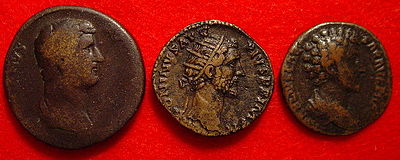Our website is made possible by displaying online advertisements to our visitors.
Please consider supporting us by disabling your ad blocker.
Dupondius
This article needs additional citations for verification. (July 2015) |

| |
| O: Trajan wearing radiate crown | R: Tropaion |
| Orichalcum dupondius struck in Rome 104
ref.: RIC 586 | |

| |
| O: Draped bust of Faustina the Younger | R: Sitting Pudicitia |
| Orichalcum dupondius struck in Rome c. 147–150
ref.: RIC 1404(b) | |

| |
| O: Didius Julianus wearing radiate crown | R: Fortuna holding cornucopia and gubernaculum (rudder) on globe |
| Very rare dupondius struck in Rome 193
ref.: RIC 12. | |
The dupondius (Latin two-pounder) was a brass coin used during the Roman Republic and Roman Empire valued at 2 asses (4/5 of a sestertius or 1/5 of a denarius during the Republic and 1/2 of a sestertius or 1/8 of a denarius during the time of Augustus).
The dupondius was introduced during the Roman Republic as a large bronze cast coin, although even at introduction it weighed less than 2 Roman pounds (librae). The initial coins featured the bust of Roma on the obverse and a six-spoked wheel on the reverse. A loaf of bread or a sextarius (c. 0.5 L) of wine cost roughly one dupondius at the height of the Roman Empire, though due to the debasement of the denarius over the following century, the dupondius was discarded.
With the coinage reform of Augustus in about 23 BC, the sestertius and dupondius were produced in a type of brass called orichalcum[1] by the Romans and numismatists, while lower denominations were produced out of reddish copper. However, some dupondii were made entirely from copper under Augustus, while under Nero some asses were made from both orichalcum and copper, instead of only copper for asses coined until then. Therefore, the latter can only be distinguished from dupondii by their smaller size instead of by also the appearance of the metal.[2][3]
The dupondius was normally further distinguished from the similarly sized as with the addition of a radiate crown to the bust of the emperor in 66 AD during the reign of Nero. Using a radiate crown to indicate double value was also markedly used on the antoninianus (double denarius) introduced by Caracalla and the double sestertius.[4][failed verification] Since dupondii minted prior to and during the reign of Nero, and occasionally under later rulers, lack the radiate crown, it is often hard to distinguish between the as and the dupondius due to heavy patina which often obscures the coin's original color[citation needed].
An extremely rare dupondius from the reign of Marcus Aurelius, dated to 154 or 155 and in excellent condition, was discovered in 2007 at the archaeological site in Draper's Gardens, London[citation needed].


- ^ Louvet, Edouard. "Roman Coinage, Chapter III: Augustus Reform". Edouard Louvet. Monedas Romanas. Archived from the original on 24 October 2016. Retrieved 27 July 2015.
- ^ "Ancient Coin Vocabulary". www.forumancientcoins.com. Retrieved 2019-05-06.
- ^ "index". augustuscoins.com. Retrieved 2019-05-06.
- ^ Louvet, Edouard. "Roman Coinage, Crowns". Edouard Louvet. Monedas Romanas. Archived from the original on 7 February 2018. Retrieved 27 July 2015.
Previous Page Next Page


